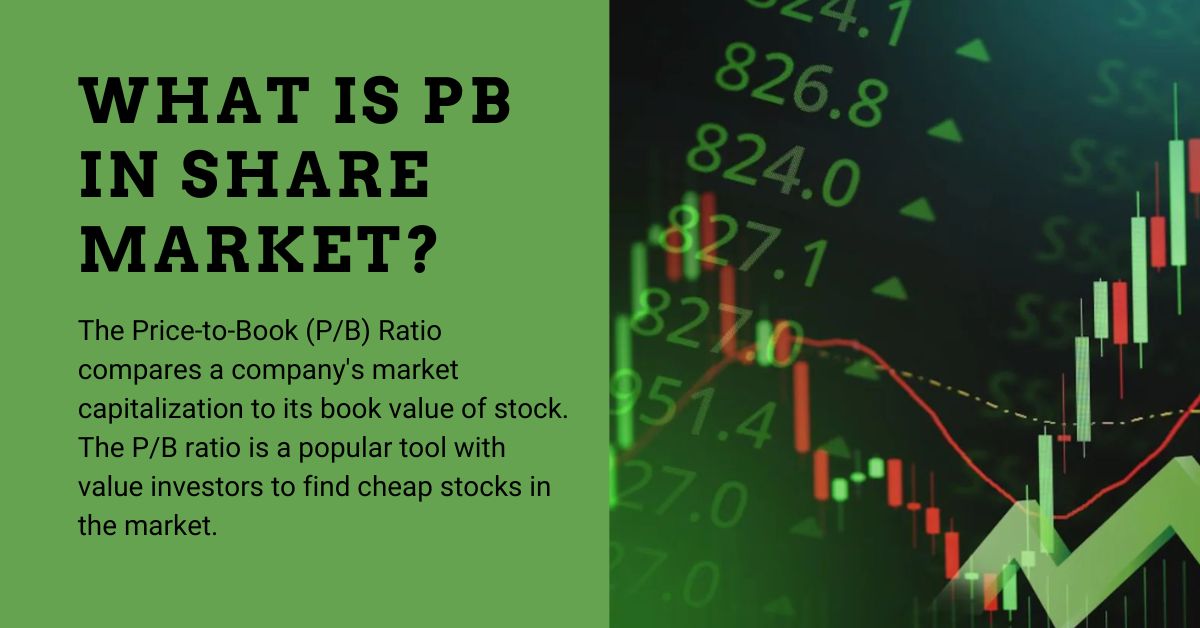The price-to-book ratio (P/B) ratio is a financial ratio that compares the market value of a company with its book value and helps investors assess whether a share is overvalued or undervalued. It is calculated by dividing the market price per share by the book value per share.
A low price-to-book ratio may indicate an undervaluation, while a high ratio indicates an overvaluation. The price/book ratio has its limitations, however, as it does not take into account intangible assets and historical costs, for example. It is best suited to asset-intensive industries and should be used alongside other ratios and qualitative analysis to make informed investment decisions.
With countless companies listed on the stock market, deciding which company to invest in can be exciting and difficult. Fortunately, an investor doesn’t always have to rely on their senses when investing; instead, they can approach the process carefully.
They can use certain metrics such as ‘return on assets‘, ‘earnings per share‘, “return on invested capital‘ and the ‘price-to-book ratio’ to analyze the value of company stocks.
We will talk about the price-to-book ratio, which is sometimes referred to as the PB ratio, P/B ratio or market-to-book ratio.
What is PB in Share Market?

PB stands for price-to-book ratio on the stock market. It’s a financial ratio that compares the market value of a company with its book value.
- Market value: This is the current share price multiplied by the number of shares outstanding.
- Book value: This is the net assets of a company, calculated as total assets minus total liabilities. It’s essentially the value of a company’s assets if it were liquidated.
The PB ratio is calculated by dividing the market price per share by the book value per share. A higher PB ratio generally indicates that the market is valuing the company at a premium to its book value, suggesting strong growth potential or intangible assets such as brand value. Conversely, a lower PB ratio may indicate undervaluation or potential financial distress.
Value investors often use the PB ratio to identify undervalued companies by looking for stocks with a low PB ratio compared to their industry peers or historical averages.
However, it’s important to note that the PB ratio has limitations, as it doesn’t fully account for intangible assets or potential future growth, for example. For a comprehensive analysis, it’s best used in conjunction with other financial ratios.
How Do You Calculate the Price-to-book Ratio?
Here you can find out how to calculate the price-to-book ratio (P/B ratio), with details of the individual steps:
Formula:
Price-to-book ratio (P/B) = market price per share / book value per share
Steps:
Market price per share: Determine the current market price of the company’s stock. This information is readily available on financial websites or stock trading platforms.
Book value per share: Calculate the company’s current book value per share. This information can be found in the company’s financial reports, usually in the balance sheet.
Calculate the quotient: Divide the market price per share by the book value per share.
Here is a simplified example of the price-to-book ratio (P/B):
Let’s imagine a bakery
- Book value: Let’s assume the bakery’s equipment, ingredients and building are worth ₹10,000 minus all debts. This is the book value.
- Shares: The bakery is divided into 1,000 shares (like dividing a cake!). So each share represents ₹10 of the bakery’s assets.
- Market price: People believe that the bakery makes delicious cakes, so they’re willing to pay ₹25 per share on the market.
Calculating the price-earnings ratio:
P/B ratio = market price per share / book value per share
P/B ratio = ₹25 / ₹10 = 2.5
What does this mean?
The price-to-book ratio of 2.5 shows that investors are willing to pay 2.5 times the actual asset value of the bakery per share. This shows that they believe the bakery has the potential to earn more than its current assets are worth.
How does the Price-to-book (P/B) Ratio Work?
The price-earnings ratio (P/B ratio) is an investment tool that compares a company’s current share price with its book value per share. It provides a method of determining whether the market considers a company’s shares to be undervalued or overvalued compared to their book value.
Advantages
- Simplicity: The P/B ratio is relatively easy to calculate and understand.
- Potential value discovery: It is particularly useful for value investors looking for potentially undervalued companies, especially in asset-intensive industries where book value may more accurately reflect a company’s underlying value.
- Industry comparisons: It is a useful tool for comparing companies in the same industry as it provides a baseline valuation.
Drawbacks
- Ignores intangibles: The P/B ratio a lot undervalues companies with large intangible assets (brands, intellectual property) that do not appear on the balance sheet. This is particularly important for modern technology and service-oriented companies.
- Outdated Data: Book value is based on the historical cost of assets and may not reflect current market conditions where asset prices have changed significantly.
- Susceptible to manipulation: Accounting techniques, such as various expiration methods, can affect the book value.
My Thoughts
The price-to-book ratio (P/B ratio) is a key component in the comprehensive analysis of the investment puzzle. It provides a starting point for value-oriented investors but should never be used in isolation. In my opinion, it’s best applied as follows:
- Screening tool: The P/B ratio can help to make an initial selection of companies that may be trading below their net worth, which requires further investigation.
- Industry-specific valuation: It’s best suited for comparing companies in the same industry that are based on similar tangible assets.
- Not the only metric: The P/B ratio is most useful when combined with metrics such as return on equity, growth prospects, leverage, and a qualitative assessment of a company’s intangible assets.
Overall, the P/B ratio provides a snapshot of market thinking versus accounting value, but a thorough assessment of a company’s investment potential requires a more comprehensive approach.
What Does a Negative P/B Ratio Mean?
A negative P/B ratio indicates that the company’s shares are trading at a lower value than the total value of its assets minus its liabilities. This usually means that the company is in a financial crisis, the industry is facing challenges or the market is severely undervaluing the company’s potential.
While this can sometimes mean hidden value for risk-averse investors, it is usually a warning that investors are worried about the company’s future. So if you notice a negative P/B ratio, you should investigate further to find out why the market feels so gloomy about the company.
What Is a Good P/B Ratio?
Broadly speaking, a P/B ratio of less than one indicates that a company is undervalued, while a ratio of more than one indicates that the company’s shares are trading at a premium. However, what this tells us about a company varies from industry to industry. Depending on the industry, a company’s P/B ratios may be lower or higher.
Tips for Investors for Selecting Stocks Based on P/B Ratio
Here are some useful tips for people who want to invest in shares and use the price-to-book ratio (P/B ratio) in their decisions:
- It depends on the sector: Price-to-book ratios are most similar within the same industry. Of course, average price-to-book ratios differ from sector to sector.
- Not all assets are equal: The P/B ratio works best for companies with many tangible assets (e.g., in manufacturing or real estate). It’s less reliable for companies whose value is based on intangible assets (such as brands and patents).
- Check indebtedness: Look out for companies with low levels of debt. A high level of debt can affect the book value, making the P/B ratio less meaningful.
- Future prospects are important: Don’t just look at the past. Also consider a company’s growth prospects and long-term potential. A company with a low P/B company may be cheap for good reason.
- It’s just one tool: never rely solely on the P/B ratio. Combining it with other valuation indicators and fundamental analysis provides a comprehensive picture of a company.
- Historical P/B: To identify trends, compare the company’s current P/B ratio with its previous values.
- Industry average: Compare the company’s P/B ratio with the average P/B of its industry.
Why is the P/B Ratio Important?
The P/B ratio) is a tool for investors looking for attractive investment opportunities. It compares the share price of a company with its “book value”, i.e. the value of its assets as shown in its accounts.
A low price/book value ratio can mean that the stock is a bargain, as you are paying less on the market than the company’s assets are actually worth. This ratio is particularly important when analyzing companies with many tangible assets, such as factories, land or equipment.
Think of the P/B ratio as a technique for determining how market excitement for a stock correlates with the actual financial stability of the company. However, it is crucial to realize that the P/B ratio does not reflect the entire story.
Some assets, such as a strong brand name or cutting-edge technology, are critical to a company even if they do not appear on the balance sheet. Therefore, it is best to use the P/B ratio along with other analytical tools when selecting a stock.

